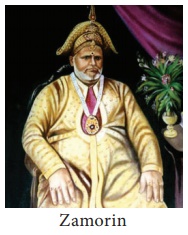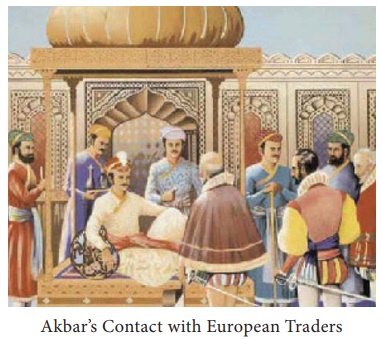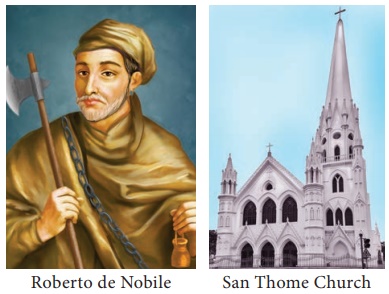Arrival of Europeans and the Aftermath - Portuguese in India | 11th History : Chapter 16 : The Coming of the Europeans
Chapter: 11th History : Chapter 16 : The Coming of the Europeans
Portuguese in India
Arrival of Europeans and the Aftermath
Portuguese in India
During his first voyage Vasco da Gama came with 170
men in three vessels. The cordiality of Zamorin, the ruler of Calicut, made him
comfortable. He journeyed back on 29 August 1498 with only fifty five surviving
men and of the three ships, two were laden with Indian goods. Gama’s success
made Portugal to

On 29 October 1502 Gama visited Calicut for the second time with a
fleet of 20 vessels. Gama moved from Calicut to Cochin as its harbour was
better. He soon realized that the monopolistic trade of the Arabs needed to be
broken if European trade was to thrive. He used the enmity between the two
Hindu rulers of Cochin and Calicut for this

Consolidation of the Portuguese Trade
The Portuguese stopped yearly expeditions and
instead decided to appoint a Viceroy. The first Viceroy was Francisco d’
Almeida who followed what is known as ‘Blue Water Policy,’ and accordingly, he
added more ships to strengthen the navy rather than adding more settlements. He
destroyed the fleet of Zamorin and a fleet sent by the Sultan of Egypt. He
befriended the ruler of Cochin and built fortresses at Cochin, Kannur and other
places on the Malabar coast.
Albuquerque (1509-1515), the successor of Almeida,
was the real founder of the Portuguese empire in India. He defeated Yusuf Adil
Khan, the ruler of Bijapur in 1510 and captured Goa. He developed Goa into a
centre of commerce by making all the ships sail on that route. He encouraged
people of all faiths to settle in Goa. He was in favour of Europeans marrying
Indian women and settling down in Portuguese controlled territories. His
conquest of Malacca (in Malaysia) held by
He attacked the Arabs and
was successful in taking Aden. In 1515 he took control of Ormuz.
Two more viceroys played a significant role in
consolidating the Portuguese empire in India. They are Nino da Cunha and
Antonio de Noronha. Da Cunha occupied Bassein and Diu in 1534 and 1537
respectively. The port of Daman was wrested from the hands of Imad-ul Mulk in
1559. Meanwhile in the middle of the sixteenth century, the Portuguese control
over Ceylon increased with the completion of a fort in Colombo. It was during
the period of De Noronha (1571) the Mughal ruler Akbar visited Cambay in
Gujarat and the first contacts between the Portuguese and the Mughal emperor
established.

In 1580 Philip II, King of Spain, defeated Portugal
and annexed it. In India the Dutch defeated the Portuguese in Ceylon and later
seized the Portuguese fort on Malabar Coast. Thereafter rather than protecting
their settlements in India, Portuguese began to evince greater interest in
Brazil.
The Impact of Portuguese Presence
·
For the first time in the political
history of India the Europeans conquered and seized territories from the
Indian rulers.
·
Indian rulers remained divided and Europeans took advantage of it.
·
The Europeans adopted new methods in the warfare. Gun powder and superior artillery played a
significant role.
·
The Portuguese could contain the monopolistic trade of the Arabs. But it did not really help them.
Instead, it benefited the British who removed pirates on the sea routes and
made the sea voyage safe.
·
The marriages between Europeans and Indians, encouraged by the Portuguese in the territories
occupied by them, created a new Eurasian racial group. They were the ones who
were later taken to other Portuguese colonies in Africa and Asia.
·
The presence of Portuguese is very much evident in Chennai’s San Thome. Mylapore was the Portuguese
‘Black Town’. (Black Town of the British period was George Town)
·
Following the establishment of
Portuguese settlements, Jesuit missionaries visited India. Notable among them
are: 1. Fr. Roberto de Nobili, whose linguistic ability enabled him to write
extensively in Tamil and Sanskrit. He is considered the father of Tamil prose.
2. Fr. Henriques introduced printing in Tamil and is called the father of
printing press.

Clashes occurred between the Portuguese and the
Muslim groups on the pearl fishery coast in the 1530s over the control of
fishing and pearl diving rights and a delegation of Paravas complained to the
Portuguese authorities at Cochin about the atrocities inflicted on them by Arab
fleets and sought protection. Seizing the opportunity, the Portuguese sent
their Roman Catholic priests (Padres) who converted thousands of fisher people
to the Catholic religion. Following this St. Francis Xavier, one of the
founders of the Society of Jesus, arrived in Goa in 1542 and travelled as far
as Thoothukudi and Punnakayal to baptize the converts. Xavier established a
network of Jesuit mission centres. His visit is evident from the shrines dedicated
to St. Xavier and the towering churches that came up in the fishing villages on
the Coromandel Coast.
The Portuguese threatened disruption of trade by
violence unless their protection, cartaz,
was bought. Under the cartaz system,
the Portuguese exacted money from the traders as price for protection against
what they termed as piracy. But much of this was caused by Portuguese
freebooters themselves and so the whole system was a blatant protection racket.
Related Topics